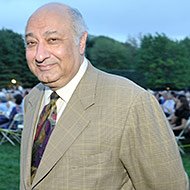
When the now-42-year-old Alan Gilbert began his tenure as music director of the New York Philharmonic last year, the aisles of Avery Fisher Hall buzzed with murmurs about change. If the talk was hushed and hesitant, thatÔÇÖs partly because GilbertÔÇÖs more wild-eyed initiatives ÔÇö a new music ensemble! giant operas! multimedia shows! ÔÇö would need approval from the orchestraÔÇÖs sober chief executive, Zarin Mehta. The 72-year-old former accountant, who has been running classical-music establishments for nearly 30 years and the Philharmonic for 10, is hardly a reactionary. He took the orchestra to North Korea, led it through a brutal recession, and eased it into the Internet age. It was he who groomed and hired Gilbert.
The musicians liked Gilbert, but a fissure appeared in the orchestraÔÇÖs administrative culture. Some staff members thrilled to the conductorÔÇÖs quiet radicalism; others insisted that the PhilharmonicÔÇÖs finances could tolerate only a slow drip of risk. As a result, the institution has been changing course with the nimbleness of a cruise ship in a swamp. Last season, Gilbert wanted to stage Le grand macabre, a gleefully unhinged opera by Gy├Ârgy Ligeti from the seventies. Fine, he was told, you can have three (instead of the usual four) nights, including Memorial Day weekend ÔÇö when nobodyÔÇÖs in town anyway. The implied message was: Once it flops, weÔÇÖll get to say, ÔÇ£I told you so.ÔÇØ Gilbert called a meeting to discuss fresh ways of marketing the program, something music directors rarely meddle with. He starred in jokey teaser videos with a hooded Grim Reaper. All three performances sold out.
Last week, shortly after Gilbert launched his second season, Mehta announced his resignation. He wonÔÇÖt actually leave for two more years, but by declaring himself a long-term lame duck, he has made it clear that the orchestraÔÇÖs future is with the younger generation. And with the right artistic vision, the New York Philharmonic could become the most progressive orchestra in the country and finally squelch some enduring stereotypes. The symphony orchestra is not a snobbish relic. The Philharmonic, like most comparable organizations, educates schoolkids, covets neophyte audiences, plays new music, and releases live recordings on iTunes. Attending a concert at Avery Fisher Hall can cost less than going to a Yankees game. Yet for years, each new campaign to make the orchestra seem less forbidding, elitist, and out of touch only made it appear more so.
Gilbert can dissolve those misconceptions, but only if he has the right team. Whoever succeeds Mehta will surely have studied the Los Angeles Philharmonic, whose fearless chief executive Deborah Borda forged powerful bonds both with the former music director Esa-Pekka Salonen and his successor Gustavo Dudamel. Together, they have led L.A.ÔÇÖs recent adventures in high culture, put classical music on the cityÔÇÖs cultural map, and built its major architectural landmark, Walt Disney Hall. TheyÔÇÖve also shown that artistic boldness is what symphonic music is all about ÔÇö which is exactly GilbertÔÇÖs point.


